|
Special Features





Image Libraries


|
|
Blog
I’ve definitely had the conversation depicted on this ad, which is hanging in a Metro station. It’s like WMATA doesn’t get me at all.
Anybody else?
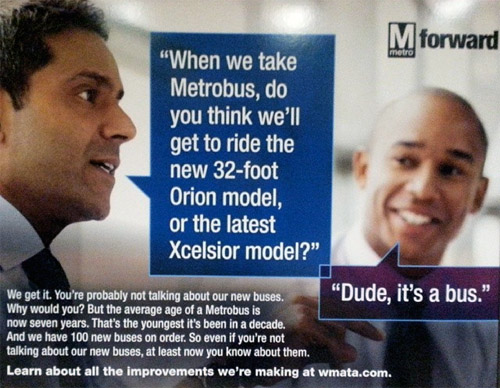
 Cross-posted at Greater Greater Washington. Cross-posted at Greater Greater Washington.
Average Rating: 4.8 out of 5 based on 262 user reviews.
January 31st, 2014 | Permalink
Tags: bus, transportation

This map shows approximately how much snow it takes to cancel school in various parts of the United States.

Map from Reddit user atrubetskoy.
On Reddit, the map’s author explains the methodology:
[It’s from a] combination of a /r/SampleSize survey, City-data.com threads, NOAA maps and some other local news sources.
So while it may not be the most precise or reliable data, it’s still an interesting general look at snow closure patterns around the country.
 Cross-posted at Greater Greater Washington. Cross-posted at Greater Greater Washington.
Average Rating: 4.5 out of 5 based on 168 user reviews.
January 30th, 2014 | Permalink
Tags: environment, maps

In the ongoing debate about where and when to build streetcars, the topic of whether they should run in mixed-traffic or dedicated lanes is a major point of contention. But outside the ivory tower of the blogosphere, it’s not an ideological question so much as a contextual one.

Like many cities, Portland builds both.
Virtually all transit advocates agree that both rail and buses run better when you give them a dedicated right of way. But since real life isn’t SimCity, cities only dedicate space to transit where the geographic and political context allows.
For most cities, that means dedicated transitways sometimes, and mixed-traffic others.
But Stephen Smith, who blogs at Next City and Market Urbanism, has made it a point to categorically attack mixed-traffic streetcars:
Smith admits that Europe does build mixed-traffic streetcars, but argues theirs usually have fewer and shorter mixed-traffic segments.
While the lines Malouff mentioned do at times travel in lanes with cars, these segments are, with one exception, very short.
That’s true. It’s because European cities are starting from a stronger transit context than most US cities. Many of them still run their original mixed-traffic trolley networks, so they don’t need to build those now. Meanwhile, with such convenient transit networks already in place, taking lanes from cars is more politically palatable.
Yet still, Stephen admits that European cities use mixed-traffic when the context is appropriate.
Of course that’s what they do. That’s what US cities do too. That’s what everyone does.
That’s why DC’s east-west streetcar runs in mixed-traffic on H Street but will have a dedicated transitway downtown, why Arlington’s streetcar runs in mixed-traffic on Columbia Pike but in a transitway in Potomac Yard, and why Seattle’s South Lake Union streetcar runs in mixed-traffic on Westlake Avenue but in a transitway on Valley Street.
Context is why Tacoma and Houston have transitway streetcars, while Tucson and Atlanta will have the exact same vehicle models running in mixed-traffic. It’s why Salt Lake City’s “light rail” sometimes runs in the street, while its “streetcar” runs in an old freight corridor. And it’s why Portland runs a mixed-traffic streetcar line and a dedicated-lane light rail one on perpendicular streets through the same intersection.
And it’s why half the cities in Europe run a combination of mixed and dedicated trams.
That isn’t an argument for or against mixed-traffic streetcars, nor for or against BRT, nor for or against anything. It’s an admission that everyone builds the best thing they can based on the circumstances of where they are, who they are, and what they’re trying to accomplish.
It’s an admission that context matters, and we all make decisions based on real world constraints and opportunities rather than black and white dogma.
Don’t use hypothetical perfects to ruin real life goods
Smith is right that every streetcar line in America that’s planned to run in mixed-traffic would be better if it had a transitway. Every one. In the places where dedicated lanes aren’t proposed, it’s totally appropriate to ask why not, and advocate for their inclusion. Transit advocates should absolutely be doing that.
But if we don’t get everything we want, we need not take our ball and go home. There are plenty of benefits to streetcars besides where they run, plenty of room for meaningful transit improvements even without a lane.
Sometimes there’s a good reason for running in mixed-traffic. Probably not as often as it actually happens, but sometimes. For example on Columbia Pike, where Arlington is prohibited from taking lanes.
Even if the only reason is political, as it seems to be in Cincinnati, some places face such a monumental uphill battle to get anything transit-related done, even a single mixed-traffic streetcar can raise regional transit ridership by almost 10%. That’s a huge victory in a place where holding out for something perfect would likely kill the project completely.
What transit advocates shouldn’t be doing is falsely claiming that nobody except misguided Americans builds streetcars. It’s not true and it’s not helpful. Broad brush attacks lead others to pen bogus anti-rail screeds with misleading information.
So by all means, let’s do more to fight for transitways. But in our attempts to do so, let’s not tear down the places that for whatever reason are merely capable of making good investments instead of perfect ones.
For the record, the same argument is true for BRT. Sometimes it’s the right answer, even though BRT creep, where costly transit features are stripped away to save money, is often a problem.
 Cross-posted at Greater Greater Washington. Cross-posted at Greater Greater Washington.
Average Rating: 4.6 out of 5 based on 232 user reviews.
January 29th, 2014 | Permalink
Tags: lightrail, streetcar, transportation

Despite cities’ reputation as concrete jungles, most have a healthy collection of wildlife. Birds, rodents, deer, anything that can live on the margins of human activity. But what happens to that wildlife when the city is hit with winter weather?
With temperatures consistently below freezing, and even the mighty Potomac River frozen all the way across at points, wildlife is going to be looking for drinkable water. On Saturday, I dropped by fast-flowing Rock Creek to try and spot some. I wasn’t disappointed.
 |
 |
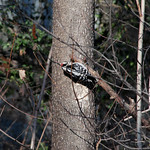 |
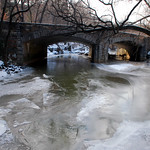 |
| A Northern Flicker (top), Starlings (bottom left), a Downy Woodpecker (bottom center), and my viewing spot near P Street Beach (bottom right). |
 Cross-posted at Greater Greater Washington. Cross-posted at Greater Greater Washington.
Average Rating: 5 out of 5 based on 164 user reviews.
January 27th, 2014 | Permalink
Tags: environment, galleries

Transit advocates want bus lanes on 16th Street, and DDOT’s latest moveDC plans call for them, but at a recent meeting, Ward 4 Councilmember and mayoral candidate Muriel Bowser expressed skepticism that they’re possible.
Here’s how they might be able to work.
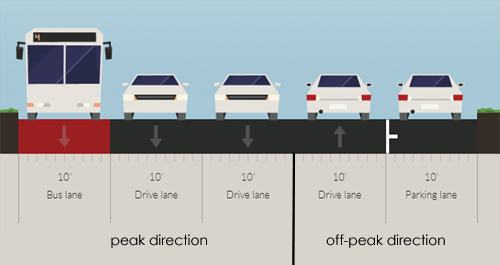
Image created using Streetmix.
Yes, 16th Street really is that wide
16th Street is 50 feet wide, curb to curb, for pretty much its entire length. But those 50 feet are arranged in three different configurations, depending on the location.
North of Arkansas Avenue, 16th Street has two lanes in each direction with a raised median down the middle. The presence of that median makes this section the hardest to change.
Between P Street and W Street, 16th Street only has four lanes and lacks a median. But it’s still 50 feet wide. The four lanes are just excessively wide.
Between Arkansas Avenue and Park Road, 16th Street’s same 50-foot width is split into five 10′ lanes. This section is the most informative, and illustrates how a bus lane might fit in.

Image created using Streetmix.
Flexible lanes are the key
There are many demands on 16th Street. Residents want on-street parking. Drivers want two lanes open for cars in each direction. Transit riders want bus lanes.
Ideally we could accommodate all that on one street and still keep it pedestrian-friendly. But with exactly 50 feet to work with, compromises are necessary.
At off-peak times, both car and bus traffic on 16th Street moves pretty well with just one lane in each direction, leaving the curbside lanes for on-street parking. It’s only at rush hour that more lanes are really necessary.
The solution so far has been to restrict parking at rush hour, allowing the curbside lane to carry traffic at peak times. But north of Arkansas Avenue and south of W Street, where 16th Street is configured with only four total lanes, that solution leaves out a dedicated bus lane.
Using the five lane configuration, however, allows the curbside lane to become a bus-only lane at rush hour, while leaving the center reversible lane as a 2nd general traffic lane. For the most part, everybody gets what they want.
Theoretically, DDOT could apply this configuration to the existing five lane stretch of 16th Street more or less immediately. And although the median north of Arkansas Avenue is hard to change, restriping the four lane section south of W Street should be relatively easy.
And while a peak-period bus lane between P Street and Arkansas Avenue might not be as great as a full busway all the way from Silver Spring to K Street, it would still be one heck of an improvement over current conditions.
Will this actually happen?
Of course, what’s theoretically possible and what’s practically achievable aren’t always the same. DDOT would need to study this much more closely before implementing it.
One potential holdup is that 10 feet is awfully narrow for a bus lane. Usually bus lanes are 11 or even 12 feet wide. But 10-foot lanes seem to be working now between Park and Arkansas, so why not further south as well?
A pilot project on the existing five lane section might help determine if this is a workable configuration.
Dupont Circle ANC Commissioner Kishan Putta suggested a pilot project in December. According to Putta, DDOT staff “said they were interested.” That’s certainly encouraging.
As for Bowser, she sent this statement in an email to Ken Archer, who had tweeted about the news:
“I never said I don’t support bus lanes. As I recall, I believe I said I don’t think it would work on 16th Street; though I was not responding to any specific proposal. My response was based on my many years of observing traffic patterns on the corridor– but not actual data. I went on to say, which has unfortunately not shown up in your tweets, that signal prioritization is a strategy on the books, with funding that needs to be implemented. As I mentioned to you, I’m happy to review and consider an actual dedicated bus lane proposal that proves to help the most people.”
 Cross-posted at Greater Greater Washington. Cross-posted at Greater Greater Washington.
Average Rating: 4.7 out of 5 based on 241 user reviews.
January 23rd, 2014 | Permalink
Tags: BRT, bus, transportation

Yesterday, the first of three new US-built streetcar vehicles arrived in DC. It joins the three Czech-built streetcars DDOT has had in possession since 2009.
Since the US-built versions were designed using the plans from the Czech version, the two streetcar models are very, very similar. But for the transitphiles out there who want to tell the difference, here’s a side by side comparison:
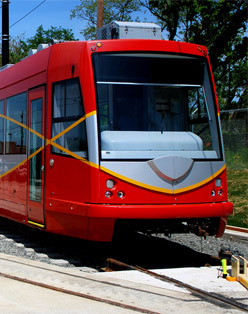
Czech-built version. |
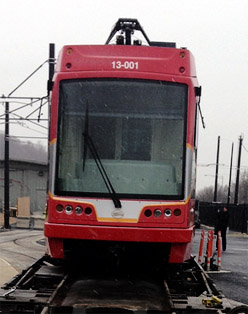
US-built version. Photo from DDOT. |
Clearly, the fronts are a noticeably different. The Czech streetcar has a V-shaped yellow & gray stripe and 3 front-facing lights on each side. The US version has a boxy yellow & gray stripe and 4 front-facing lights per side. Also, the US version has a shell covering the mechanical fixtures on the top, while the Czech version doesn’t.
There are other minor differences to the mechanical systems, and maybe the interior layout. But the easiest way to tell the difference, by far, is the paint job on the front.
Average Rating: 4.9 out of 5 based on 285 user reviews.
January 22nd, 2014 | Permalink
Tags: streetcar, transportation

Am I crazy to actually like big highway rest stops?
Maryland’s newest one is scheduled to open along I-95 next week, following a complete reconstruction. And somehow, despite the fact that it’s merely a collection of fast food, dirty restrooms, and convenience marts, I think there will be just a touch of romance to the place.

The newly rebuilt Maryland House rest stop. Photo by MDTA.
Something about all waystations appeals to me. I know they’re mundane and often uncomfortable places, but all of them, from airports to train depots to I-95 travel plazas, somehow tickle my sense of fantasy.
I think it’s because waystations are the gathering places of travel, where humanity comes together and rests before setting off on adventure. Rest stops may not be exotic themselves, but they’re where exotic stories begin. Somehow, with hundreds of traveling partners bustling around me, being in a waystation makes travel feel like a quest.
Or maybe I’ve just got an overactive imagination. Does anyone else feel this way?
 Cross-posted at Greater Greater Washington. Cross-posted at Greater Greater Washington.
Average Rating: 5 out of 5 based on 160 user reviews.
January 16th, 2014 | Permalink
Tags: in general, question, roads/cars, transportation

Shipping containers continue to proliferate as an affordable building material. The latest addition is a new restaurant near the corner of U Street and Vermont Avenue, NW, called El Rey taqueria.
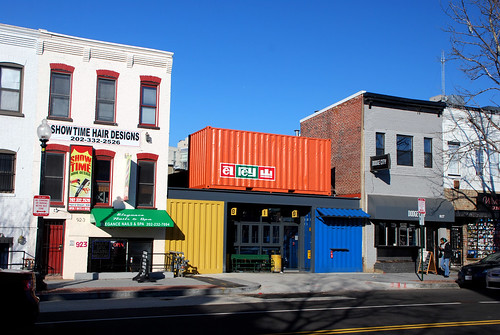
El Rey taqueria on U Street.
In this case, El Rey owner Ian Hilton says it wasn’t actually cheaper to build using shipping containers. But that could be due to El Rey’s particular layout or needs. It’s hard to know for sure.
Elsewhere in the region, shipping containers are used or will be used at Half Street Fairgrounds near the baseball stadium, and possibly in Tysons Corner.
 Cross-posted at Greater Greater Washington. Cross-posted at Greater Greater Washington.
Average Rating: 5 out of 5 based on 241 user reviews.
January 15th, 2014 | Permalink
Tags: architecture, development

In an attempt to discredit the concept of streetcars, some opponents erroneously claim that other first-world countries don’t build mixed-traffic rail. So let’s set the record straight: Yes they do. Plenty.

Mixed-traffic tram in Manchester, UK, opened in 2013.
Photo by Howard Pulling on flickr, used with permission.
I’m not an expert on European transit, but it takes about 5 minutes on Google to find numerous examples of recently-built mixed-traffic European trams.
Here’s a (most likely partial) list. The dates in parentheses are either the year trams were reintroduced to the city in question, or the year the specific mixed-traffic segment pictured in the link was built.
That’s actually longer than the list of US cities currently running newly-built mixed-traffic streetcars. As of this writing, that list is exactly two cities long: Portland and Seattle. Granted, it is about to explode, but over the past decade Europe has unquestionably built more mixed-traffic streetcars than the US.
Of course, all transit functions better in dedicated lanes. It’s completely true that many mixed-traffic streetcars in the US would benefit greatly from dedicated lanes, and will only lack them for political will. It’s also completely true that Europe is better at providing transitways for their streetcars more often than the US. None of that is in dispute.
But the fact is, many European cities have indeed recently added new mixed-traffic lines, because whether streetcar opponents care to admit it or not, there are many benefits to rail transit aside from where it runs.
But wait, there’s more
In addition to the true mixed-traffic streetcars listed above, Europe also has an entire category of trams that often run in mixed-traffic that’s completely absent from the US.
Guided tire trams run on rubber tires like a bus, but have a single in-ground track to guide them, as well as overhead wires. They’re a middle ground between buses and streetcars, and are present in mixed-traffic arrangements in multiple cities in France and Italy, at least.
It’s not exactly fair to call guided tire trams streetcars, but neither is it fair to exclude them from a discussion of mixed-traffic European trams.
If a US city wants to prove it’s serious about providing a rail-like BRT experience, they might experiment with one of these. So far, none have done so.
 Cross-posted at Greater Greater Washington. Cross-posted at Greater Greater Washington.
Average Rating: 4.9 out of 5 based on 172 user reviews.
January 13th, 2014 | Permalink
Tags: BRT, streetcar, transportation

Three other American cities in addition to DC will open new streetcar lines this year, and at least 12 more cities are expected to advance construction on lines that will open later.
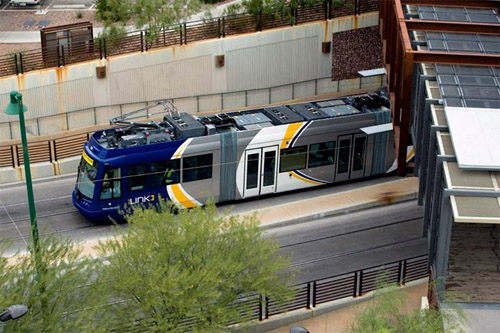
Streetcar undergoing on-street testing in Tucson, Arizona. Photo from the City of Tucson.
The four lines expected to open in 2014 are in DC, Tucson, Seattle, and Atlanta.
Tucson’s Sun Link streetcar will be the first modern rail transit to open in that city.
Seattle’s First Hill streetcar will run next to a cycletrack for much of its length, in an impressive multimodal layout.
Atlanta’s downtown streetcar will be the first modern streetcar to open in the US that doesn’t use the ubiquitous 66′ long streetcar model first popularized in Portland. Instead, Atlanta will use a 79′ long tram similar to the light rail cars in Norfolk.
North of the border, Toronto will shortly begin to use new 99′ long trams on its expansive streetcar network, the largest in North America.
Even more cities will begin construction or continue construction on new lines that won’t open until 2015 or later. They include Charlotte, Cincinnati, Dallas, Detroit, Fort Lauderdale, Kansas City, Milwaukee, New Orleans, Oklahoma City, Tempe, San Antonio, and Saint Louis.
Many other cities, including Arlington, have streetcars that aren’t expected to begin construction yet, but aren’t far behind.
 Cross-posted at Greater Greater Washington. Cross-posted at Greater Greater Washington.
Average Rating: 4.5 out of 5 based on 198 user reviews.
January 9th, 2014 | Permalink
Tags: streetcar, The New America, transportation

|
Media





Site
About BeyondDC
Archive 2003-06
Contact
Category Tags:
Partners
|

 Cross-posted at Greater Greater Washington.
Cross-posted at Greater Greater Washington.




























